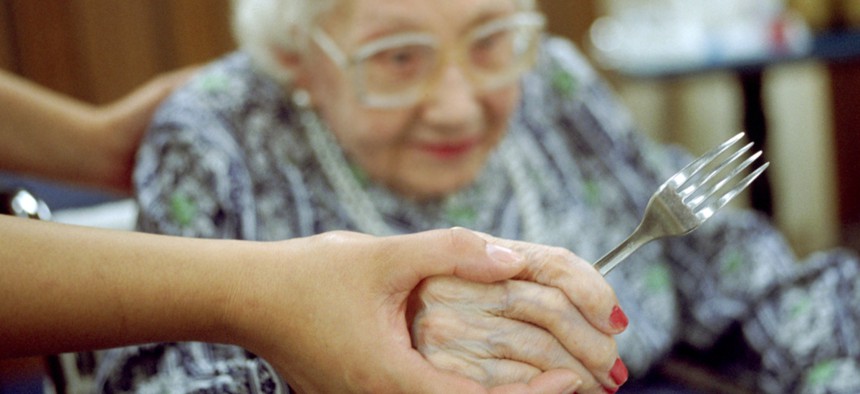The Future of American Jobs Is Taking Care of the Elderly

An elderly woman is assisted with eating at a nursing home in the Bronx, New York. Shutterstock
The number of U.S. workers in home health care jumped from less than 700,000 in 2002 to more than 1.4 million in 2017. Projections for the growth of elderly-care aides are consistent with recent history.
The future of work in the U.S. is uncertain. Artificial intelligence, self-driving cars, and the move away from full-time employment are all factors that make it increasingly unpredictable.
Yet there is one thing we do know. The U.S. population is getting a lot older, and that means more jobs caring for the elderly. A lot more.
The U.S. Bureau of Labor Statistics recently released their projections of which jobs will grow the fastest from 2016 to 2026. The Bureau expects the job of “personal-care aide” to grow faster than any other, with about 750,000 additional jobs; “home-health aide” is fourth on their list of fastest growers, adding an additional 425,000 jobs to the economy. Both jobs involve assisting people with diseases and disability, usually the elderly, as they continue to live their lives at home—the major difference being that home-health aides can legally offer some medical services.
If the Bureau is correct, these jobs would go from 2.3 million of all U.S. jobs in 2016 to about 3.4 million in 2026, accounting for 10 percent of all jobs created over the next decade.

Not only are home-health and personal-care aides growing the most in absolute terms, they also have among the fastest growth rates at 47 percent and 37 percent, respectively. “Solar installers” and “turbine technicians” are the only two occupations the Bureau expects to grow faster. But in absolute terms, these renewable-energy jobs only project to create about 16,000 jobs, a relative pittance compared to the elderly-care industry.
The projections for the growth of elderly-care aides are consistent with recent history. The number of U.S. workers in home health care jumped from less than 700,000 in 2002 to more than 1.4 million in 2017. (Historical data on personal care workers is unavailable.)

As baby boomers age into retirement, and illness makes them less able to care for themselves, elderly-care aides now do what, in previous generations, would have been done by family members. The pay for providing this care is not particularly good. In 2016, the median hourly wage for elderly-care aides was $10.66, compared to $17.81 for the average job. U.S. News & World Report rates these jobs as above average in stress level and below average in flexibility.
As baby boomers age into retirement, and illness makes them less able to care for themselves, elderly-care aides now do what, in previous generations, would have been done by family members. The pay for providing this care is not particularly good. In 2016, the median hourly wage for elderly-care aides was $10.66, compared to $17.81 for the average job. U.S. News & World Report rates these jobs as above average in stress level and below average in flexibility.
Dan Kopf writes for Quartz, where this article was originally published.
NEXT STORY: Why Prison Health Care Is Integral to Achieving State Goals





